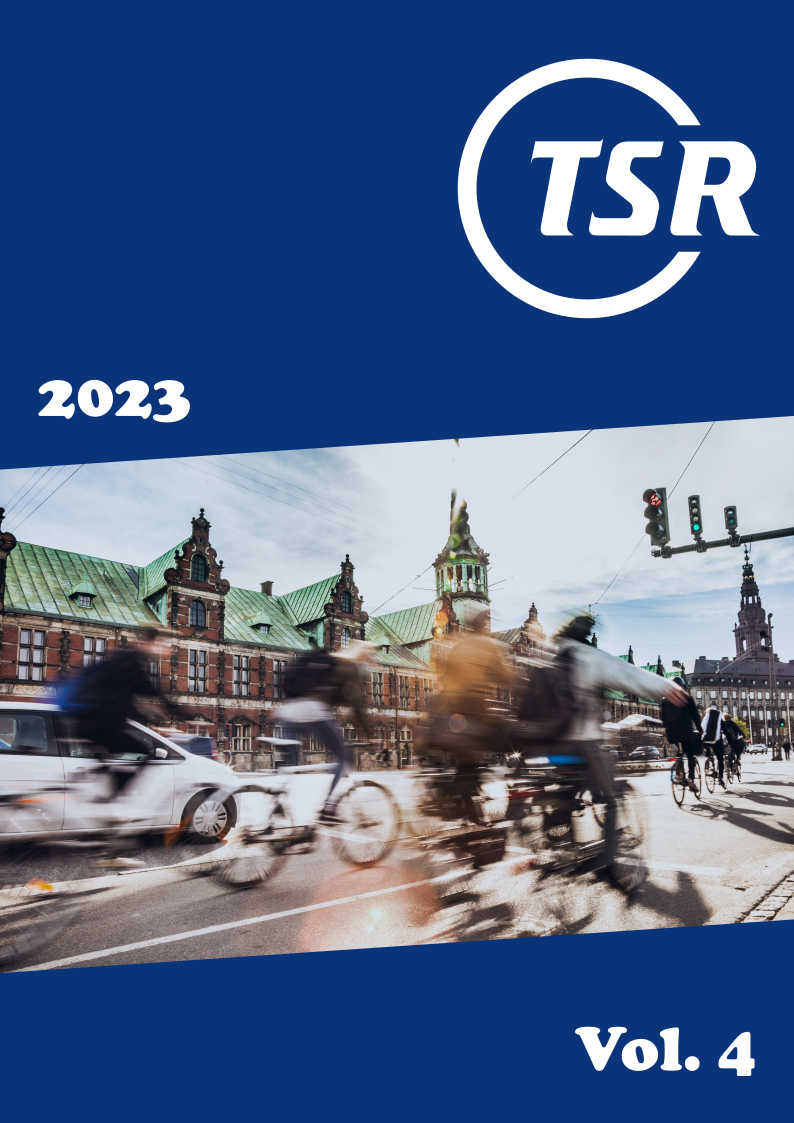Bicycling during alcohol intoxication
DOI:
https://doi.org/10.55329/prpa1909Keywords:
alcohol intoxication, bicycling performance, cognition, stabilityAbstract
The number of bicycling fatalities was 19 450 between 2010 and 2018 in Europe. The number of bicyclists killed when intoxicated by alcohol is harder to establish given the lack of reliable data. In Sweden, drunk bicycling is socially acceptable and legal (unless reckless). This experiment aimed to investigate how alcohol intoxication affect bicycling stability performance, executive functions, and self-rated ability. The experiment was completed on a wide treadmill that allowed control of several influencing factors such as speed and physical effort. Intoxicated and sober participants bicycled on the treadmill for five 10 minute sessions. Alcohol as administered incrementally to reach a target breath alcohol concentration level of 0.8‰. Stability decreased with intoxication; especially roll rate measurements were identified as being adequate indicators of bicycling instability. Executive function was negatively affected, and ability ratings decreased due to intoxication. The intoxicated participants were aware of their reduced ability to bicycle in a safe manner on a group level but not on an individual level. However, this insight does not affect their intention to bicycle intoxicated.
Downloads
References
Adminaité-Fodor, D., G. Jost (2020), 'How Safe is Walking and Cycling in Europe', European Transport Safety Council (Brussels, Belgium).
Airaksinen, N. K., I. S. Nurmi-Lüthje, J. M. Kataja, H. P. J. Kröger, P. M. J. Lüthje (2018), 'Cycling injuries and alcohol', Injury, 49(5), 945–952. DOI: https://doi.org/10.1016/j.injury.2018.03.002
Asbridge, M., R. Mann, M. D. Cusimano, J. M. Tallon, C. Pauley, J. Rehm (2014), 'Cycling-related crash risk and the role of cannabis and alcohol: a case-crossover study', Preventive Medicine, 66, 80–86. DOI: https://doi.org/10.1016/j.ypmed.2014.06.006
Boissoneault, J., A. Sklar, R. Prather, S. J. Nixon (2014), 'Effects of moderate alcohol on psychomotor, set shifting, and working memory function in older and younger social drinkers', Journal of Studies on Alcohol and Drugs, 75(5), 870–879. DOI: https://doi.org/10.15288/jsad.2014.75.870
Borg, G. A. V. (1982), 'A category scale with ratio properties for intermodal and interindividual comparisons', VEB Deutcher Verlag der Wissenschaften.
Borg, G. A. V. (1970), 'Perceived exertion as an indicator of somatic stress', Scandinavian Journal of Rehabilitation Medicine, 2(2), 92–98. DOI: https://doi.org/10.2340/1650197719702239298
Bronstad, P. M., A. Albu, R. D. Goldstein, E. Peli, A. R. Bowers (2016), 'Driving with central field loss III: vehicle control', Clinical and Experimental Optometry, 99(5), 435–440. DOI: https://doi.org/10.1111/cxo.12432
Brooks, M., R. Nguyen, R. Bruno, A. Peacock (2019), 'A systematic review of event-level measures of risk-taking behaviors and harms during alcohol intoxication', Addictive Behaviors, 99(106101), 1–10. DOI: https://doi.org/10.1016/j.addbeh.2019.106101
Cain, S. M., J. A. Ashton-Miller, N. C. Perkins (2016), 'On the skill of balancing while riding a bicycle', PLoS ONE, 11(2), 1–18. DOI: https://doi.org/10.1371/journal.pone.0149340
Cash, C., A. Peacock, H. Barrington, N. Sinnett, R. Bruno (2015), 'Detecting impairment: sensitive cognitive measures of dose-related alcohol intoxication', Journal of Psychopharmacology, 29(4), 436–446. DOI: https://doi.org/10.1177/0269881115570080
de Waard, D., S. Houwing, B. Lewis-Evans, D. Twisk, K. Brookhuis (2016), 'Bicycling under the influence of alcohol', Transportation Research Part F: Traffic Psychology and Behaviour, 41(Part B), 302–308. DOI: https://doi.org/10.1016/j.trf.2015.03.003
Eichelberger, A. H., A. T. Mccartt, J. B. Cicchino (2018), 'Fatally injured pedestrians and bicyclists in the United States with high blood alcohol concentrations', Journal of Safety Research, 65, 1–9. DOI: https://doi.org/10.1016/j.jsr.2018.02.004
Feenstra, H., R. A. C. Ruiter, G. Kok (2010), 'Social-cognitive correlates of risky adolescent cycling behavior', BMC Public Health, 10, 1–7. DOI: https://doi.org/10.1186/1471-2458-10-408
George, S., R. D. Rogers, T. Duka (2005), 'The effect of alcohol on decision making in social drinkers', Psychopharmacology, 182(1), 160–169. DOI: https://doi.org/10.1007/s00213-005-0057-9
Gevins, A., B. Cutillo (1993), 'Spatiotemporal dynamics of component processes in human working memory', Electroencephalography and Clinical Neurophysiology, 87(3), 128–143. DOI: https://doi.org/10.1016/0013-4694(93)90119-G
Greenstein, J. E., J. D. Kassel, M. C. Wardle, J. C. Veilleux, D. P. Evatt, A. J. Heinz (2010), 'The separate and combined effects of nicotine and alcohol on working memory capacity in nonabstinent smokers', Experimental and Clinical Psychopharmacology, 18(2), 120–128. DOI: https://doi.org/10.1037/a0018782
Hartung, B., N. Mindiashvili, R. Maatz, H. Schwender, E. H. Roth, S. Ritz-Timme (2015), 'Regarding the fitness to ride a bicycle under the influence of alcohol', International Journal of Legal Medicine, 129(3), 471–480. DOI: https://doi.org/10.1007/s00414-014-1104-z
Hartung, B., S. Ritz-Timme, H. Schwender, N. Mindiashvili, T. Daldrup (2015), 'Differences between male and female cyclists’ performances under the acute influence of alcohol', International Journal of Legal Medicine, 129(5), 1011–1020. DOI: https://doi.org/10.1007/s00414-015-1182-6
Hoffman, L.-A., A.-L. Skalr, S.-J. Nixon (2015), 'The effects of alcohol on psychomotor, set-shifting, and working memory performance in older men and women', Alcohol, 49(3), 185–191. DOI: https://doi.org/10.1016/j.alcohol.2015.02.001
Huemer, A. K. (2018), 'Cycling under the influence of alcohol in Germany', Transportation Research Part F: Traffic Psychology and Behaviour, 56, 408–419. DOI: https://doi.org/10.1016/j.trf.2018.05.013
Juric, A., A. Fijacko, L. Bakulic, T. Orešic, I. Gmajnicki (2018), 'Evaluation of breath alcohol analysers by comparison of breath and blood alcohol concentrations', Arhiv za Higijenu Rada i Toksikologiju, 69(1), 69–76. DOI: https://doi.org/10.2478/aiht-2018-69-3064
Kovácsová, N., J. C. F. D. Winter, A. L. Schwab, M. Christoph, D. A. M. Twisk, M. P. Hagenzieker (2016), 'Riding performance on a conventional bicycle and a pedelec in low-speed exercises: Objective and subjective evaluation of middle-aged and older persons', Transportation Research Part F: Traffic Psychology and Behaviour, 42, 28–43. DOI: https://doi.org/10.1016/j.trf.2016.06.018
Li, Z., X. Li, X. Zhao, O. Zhang (2019), 'Effects of different alcohol dosages on steering behavior in curve driving', Human Factors, 61(1), 139–151. DOI: https://doi.org/10.1177/0018720818791850
Lyvers, M., J. Tobias-Webb (2010), 'Effects of alcohol consumption on executive cognitive functioning in naturalistic settings', Addictive Behaviors, 35(11), 1021–1028. DOI: https://doi.org/10.1016/j.addbeh.2010.06.022
Macdonald, W. A., E. R. Hoffman (1980), 'Review of relationships between steering wheel reversal rate and driving task demand', Human Factors, 22(6), 733–739. DOI: https://doi.org/10.1177/001872088002200609
Macmillan, N. A., C. D. Creelman (1991), Detection Theory: A User's Guide, (Cambridge: Cambridge University Press).
Mintzer, M. Z. (2007), 'The effects of alcohol on memory: a review of laboratory studies in healthy adults', International Journal on Disability and Human Development, 6(4), 397–403. DOI: https://doi.org/10.1515/IJDHD.2007.6.4.397
MSB, (2013), 'Skadade cyklister - en analys av skadeutvecklingen över tid [Injured cyclists - an analysis of injury trends over time]', Myndigheten för samhällsskydd och beredskap.
Mumenthaler, M. S., J. L. Taylor, R. O'hara, J. A. Yesavage (1999), 'Gender differences in moderate drinking effects', Alcohol Research and Health, 23(1), 55–64. DOI: https://doi.org/10.1097/00000374-199902000-00009
Park, M. S., S. Sohn, J. E. Park, S. H. Kim, Y. I K, J. H. Sohn (2011), 'Brain functions associated with verbal working memory tasks among young males with alcohol use disorders', Scandinavian Journal of Psychology, 52(1), 1–7. DOI: https://doi.org/10.1111/j.1467-9450.2010.00848.x
Racheva, R., T. Totkova (2020), 'Reliability and validity of a method for assessment of executive functions in drivers', Behavioral Sciences, 10(1), 37. DOI: https://doi.org/10.3390/bs10010037
Rizzi, M. C., M. Rizzi, A. Kullgren, B. Algurén (2020), 'The potential of different countermeasures to prevent injuries with high risk of health loss among bicyclists in Sweden', Traffic Injury Prevention, 21(3), 215–221. DOI: https://doi.org/10.1080/15389588.2020.1730827
Saunders, J. B., O. G. Aasland, T. F. Babor, J. R. D. L. Fuente, M. Grant (1993), 'Development of the alcohol use disorders identification test (AUDIT): WHO collaborative project on early detection of persons with harmful alcohol consumption-II', Addiction, 88(6), 791–804. DOI: https://doi.org/10.1111/j.1360-0443.1993.tb02093.x
Sethi, M., J. H. Heyer, S. Wall, C. Dimaggio, M. Shinseki, D. Slaughter, S. G. Frangos (2016), 'Alcohol use by urban bicyclists is associated with more severe injury, greater hospital resource use, and higher mortality', Alcohol, 53, 1–7. DOI: https://doi.org/10.1016/j.alcohol.2016.03.005
Spinola, S., S. A. Maisto, C. N. White, T. Huddleson (2017), 'Effects of alcohol intoxication on executive functions controlling self-regulated behavior', Alcohol, 61, 1–8. DOI: https://doi.org/10.1016/j.alcohol.2017.02.177
Takeda, A., M. Koh, T. Nakanishi, M. Hitosugi (2020), 'Differences in severity of injuries between motorcyclist and bicyclist fatalities in single vehicle collisions', Journal of Forensic and Legal Medicine, 70(101917), 1–4. DOI: https://doi.org/10.1016/j.jflm.2020.101917
Wallén_Warner, H., Å. Forsman, S. Gustavsson, J. Ihlström, J. Nyberg (2017), 'Alkohol och cykling: en multidisciplinär studie [Alcohol and cycling: a multidisciplinary study]', Swedish National Road and Transport Research Institute.
Wallén_Warner, H., P. Henriksson, C. Patten (2018), 'Alkohol- och drogprevalens hos cyklister: en enkätstudie [Alcohol and drug prevalence in cyclists: a questionnaire study]', Swedish National Road and Transport Research Institute.
Wang, C., Z. Li, R. Fu, Y. Guo, W. Yuan (2019), 'What is the difference in driver’s lateral control ability during naturalistic distracted driving and normal driving? A case study on a real highway', Accident Analysis & Prevention, 125, 98–105. DOI: https://doi.org/10.1016/j.aap.2019.01.030
Weiss, E., J. Marksteiner (2007), 'Alcohol-related cognitive disorders with a focus on neuropsychology', International Journal on Disability and Human Development, 6(4), 337–342. DOI: https://doi.org/10.1515/IJDHD.2007.6.4.337
Xu, C., S.-J. Pei, X.-S. Wang (2016), 'Driver drowsiness detection based on non-intrusive metrics considering individual differences', Journal of Highway and Transport, 29(10), 118–125.
Published
How to Cite
Issue
Section
License
Copyright (c) 2023 Jan Andersson, Christopher Patten, Henriette Wallén Warner, Caroline Andersérs, Christer Ahlström, Ruggero Ceci, Liza Jakobsson

This work is licensed under a Creative Commons Attribution 4.0 International License.














